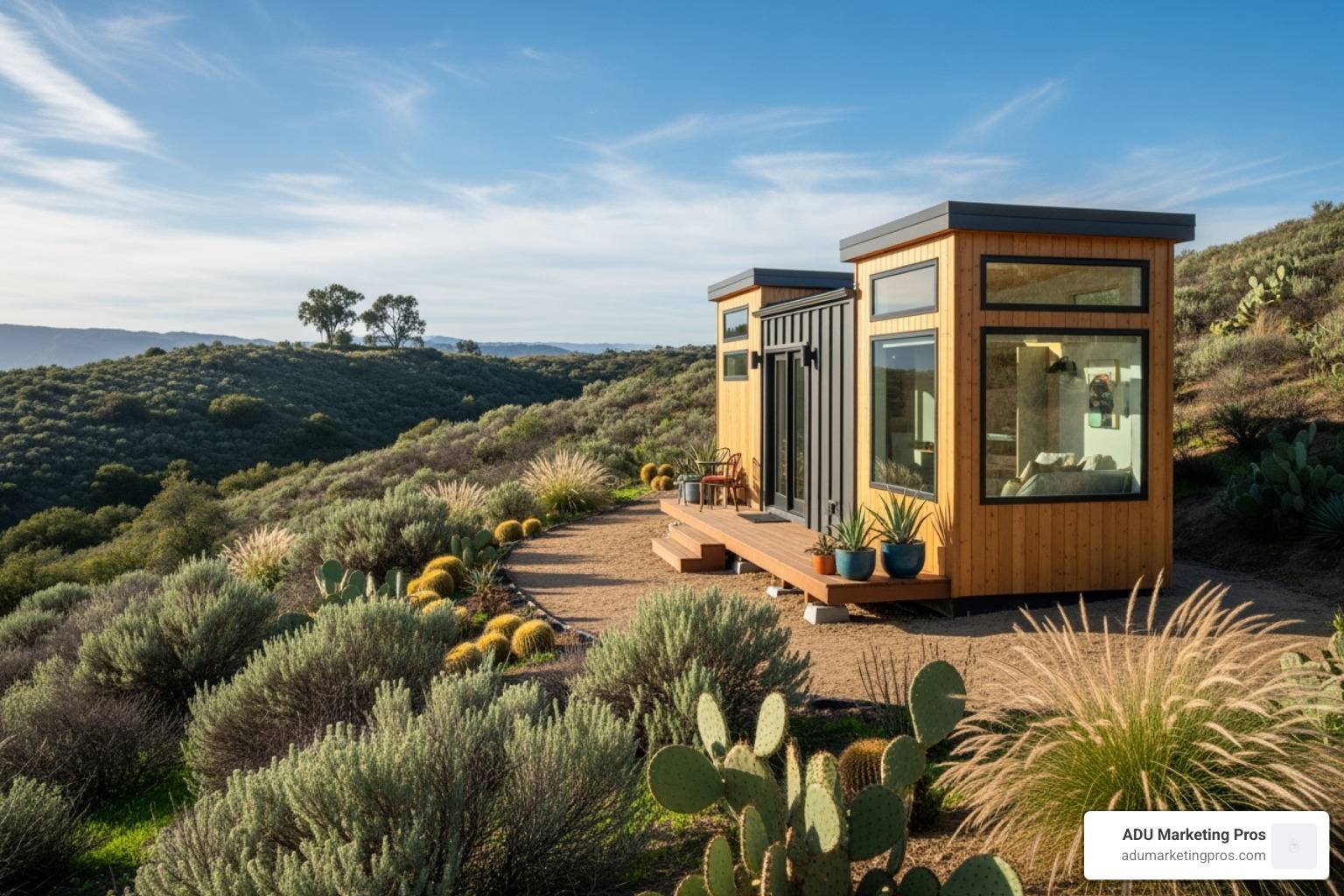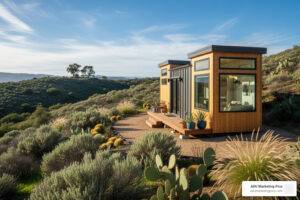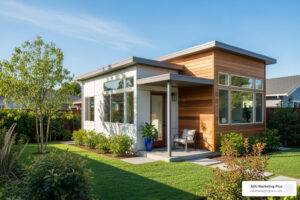Why Go Tiny in the Golden State?
Tiny house SoCal options are booming, whether you’re looking to rent for a weekend, buy a turn-key home, or hire a builder. Here’s what you need to know about joining the movement in Southern California.
With the average cost of affordable housing in LA soaring to $700,000 per unit, tiny homes present a compelling alternative. They can be built for as little as $30,000 or purchased professionally for a fraction of traditional housing costs. The appeal goes beyond affordability; from desert stargazing in Joshua Tree to coastal retreats in San Diego, tiny living in SoCal offers unique experiences that blend minimalism with the region’s diverse landscapes. This shift is embraced by a wide range of people: millennials and Gen Z seeking an escape from the rent trap, retirees looking to downsize and travel, and digital nomads who value mobility. The movement is built on a philosophy of intentional living—prioritizing experiences over possessions, financial freedom over sprawling mortgages, and a smaller environmental footprint. By consuming less energy, producing less waste, and often utilizing sustainable or reclaimed materials, tiny homeowners actively participate in a more eco-conscious lifestyle.
California is the most popular state for tiny home living, and for good reason. The state’s progressive stance on Accessory Dwelling Units (ADUs) has been a game-changer. Key Southern California counties, including Los Angeles, San Diego, Riverside, and San Bernardino, have legalized tiny homes on wheels as ADUs, provided they have the proper certification. This has opened the door for homeowners to add rental income, create multi-generational living compounds, or simply have a private guest space in their own backyards.
Whether you’re drawn to financial freedom, a smaller environmental footprint, or the charm of downsized living, the tiny house movement offers a path to intentional living in one of the most beautiful regions in the country.
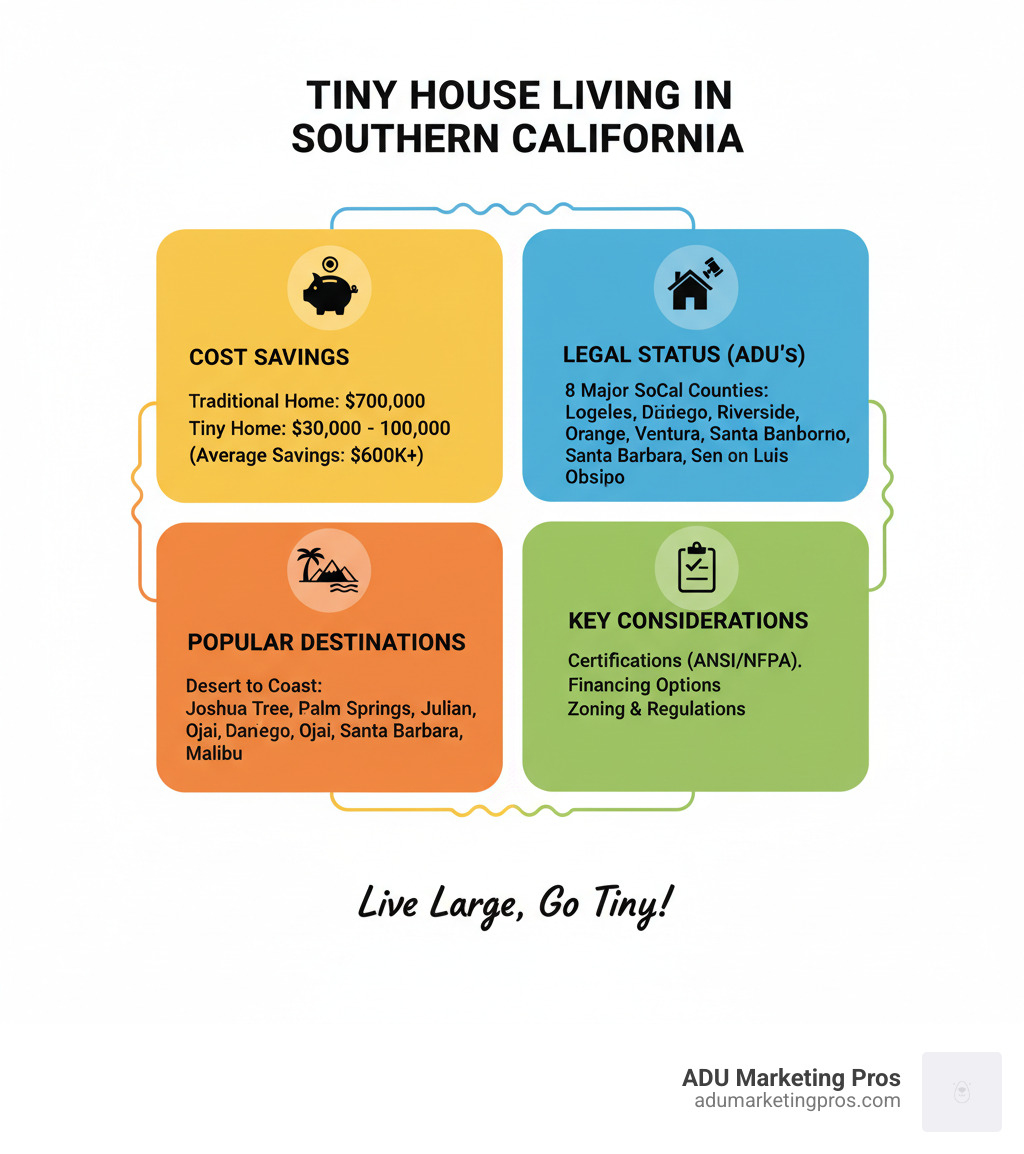
Top Destinations for Your Tiny House SoCal Adventure

Southern California’s diverse landscapes make it a playground for tiny house adventures. You can wake up to crashing waves, hike through a desert wonderland, and watch the sunset from a mountain cabin, all within a few hours’ drive. Tiny house rentals offer unique architecture and outdoor amenities like fire pits and hot tubs that traditional hotels can’t match.
Booking is simple on platforms like Airbnb, where you can filter by location and amenities. Let’s explore the best regions for your tiny house getaway.
Desert Escapes: Joshua Tree & Twentynine Palms
The desert landscapes around Joshua Tree and Twentynine Palms attract those craving tranquility and a connection with nature. Rentals range from modern cabins to vintage Airstreams, many embracing off-grid living. Outdoor showers, fire pits, and floor-to-ceiling windows for watching sunrises and sunsets are common features.
Hiking in Joshua Tree National Park is a must, but the profound peace of the desert quiet is an experience in itself. Be aware that cell service can be spotty and some roads are unpaved. For your stay, pack water bottles, sunscreen, layered clothing, hiking shoes, and a portable charger.
Coastal Retreats: San Diego to Malibu

From the surfing culture of San Diego to the cliffs of Malibu, coastal tiny homes offer minimalist living with million-dollar ocean views. Many rentals in San Diego County and Los Angeles County provide direct beach access. Some luxury tiny homes rival boutique hotels with full kitchens, Wi-Fi, and designer interiors.
The Ocean & Mountain View Tiny House Glamping property is a prime example of a coastal glamping experience, offering stunning vistas and thoughtful touches like hammocks and fire pits.
Mountain Getaways: Mount Laguna & Big Bear
For a break from the heat, head to the pine-scented air of Mount Laguna and Big Bear. These four-season destinations offer summer hiking trails and winter sports.
Tiny House Block in Mount Laguna is a standout community-focused village offering short- and long-term rentals. Located steps from the Pacific Crest Trail, it’s built on a philosophy of connecting with nature and community. Learn more at About Tiny House Block. Cabin-style tiny homes in these areas often feature wood-burning stoves and cozy interiors, perfect for relaxing after a day of adventure.
Urban & Vineyard Oases: LA, Temecula, and Ojai
A great tiny house SoCal experience doesn’t always mean a remote location. Urban and semi-urban areas offer backyard ADUs and guest houses that provide a minimalist retreat with proximity to city attractions.
In Los Angeles, tiny homes are popular as ADUs in trendy neighborhoods. In Temecula wine country, you can find tiny houses nestled among vineyards. Ojai’s artistic vibe has also acceptd tiny living. In Rainbow, CA, Coral Tree House offers a unique collection of tiny cabins and guest houses with shared amenities like a pool and jacuzzi. Experience the charm of tiny living in these thoughtfully designed communities.
Understanding the difference between an ADU and a tiny house is key, especially in urban settings. For more details, see our guide: More info about ADU vs. Tiny House.
From Dream to Reality: Buying or Building Your SoCal Tiny Home
For many, the tiny house SoCal lifestyle is a long-term commitment to homeownership, an investment, or a way to add a guest house. The path to ownership requires planning, budgeting, and the right team of experts.
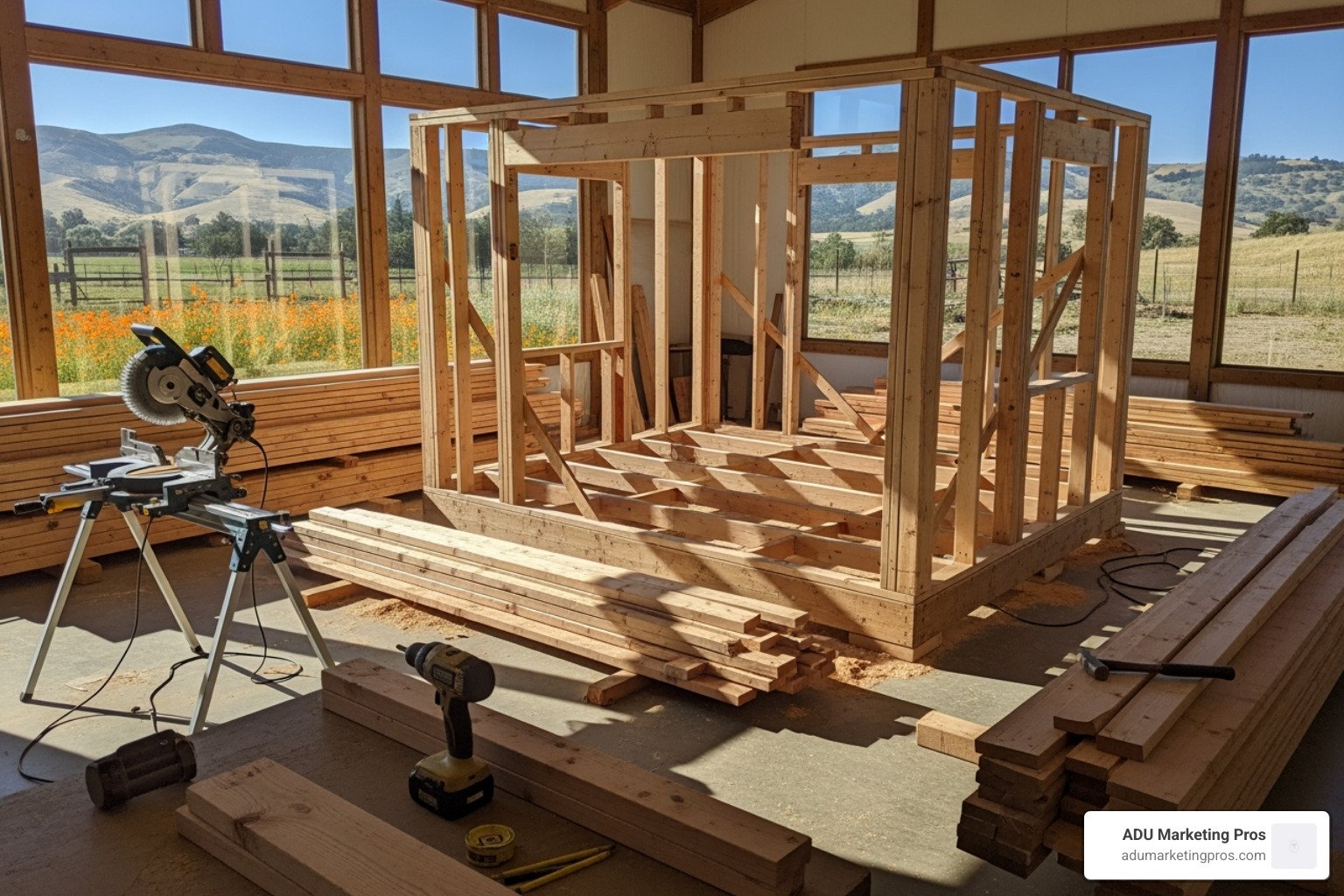
The cost of a tiny home is flexible. DIY builds can be done for as little as $5,000, while luxury custom builds can exceed $200,000. Non-profits have even built homes for around $30,000 for former foster youth, teaching valuable skills in the process. Whether you buy a pre-built home, assemble a kit, or work with a professional, there’s a path that fits your budget and skills.
Finding Tiny Homes for Sale in Southern California
The market for tiny house SoCal homes is growing. Online marketplaces list everything from shells to move-in-ready homes. Prices start around $7,200 for basic kits and can surpass $100,000 for professionally built, fully equipped houses.
A shell provides the exterior structure, leaving the interior finishing to you—a great option for saving money if you’re handy. Turn-key homes are completely finished. Pricing is influenced by square footage, materials, and customization. Used tiny homes can offer savings but require careful inspection. When inspecting a used THOW, pay close attention to the trailer for signs of rust or damage, check for level flooring, and look for any evidence of leaks or water damage, especially around windows and in the bathroom. It’s also wise to have a professional inspect the electrical and plumbing systems.
Los Angeles and San Diego have active markets. You can browse current listings at Tiny Houses For Sale In Los Angeles and Tiny Houses For Sale In San Diego. For other options, check out our resource on small houses for sale.
Partnering with Southern California’s Best Builders and Architects
For a custom tiny home, working with experienced builders and architects is essential. They understand how to maximize small spaces and steer local regulations. The process starts with a consultation to discuss your needs and budget, followed by blueprints and construction. A custom build typically takes several months.
Reputable builders like California Tiny House, Inc. and Tiny Topanga have years of experience. When vetting builders, review their portfolios, read client testimonials, and confirm their knowledge of local zoning laws. Come prepared to your consultation with a list of questions, such as:
- Are your homes certified by a third party like the RVIA or NOAH?
- Can you provide a portfolio and references from recent clients in Southern California?
- What is your typical build timeline from design to delivery?
- How do you handle customization, and what does that process look like?
- What warranties do you offer on your craftsmanship and the materials used?
A beautiful home is useless if it isn’t legal where you plan to place it.
For more help finding the right team, explore our guides on tiny house builders in Southern California and architects in Southern California who design tiny houses.
Navigating Financing and Insurance
Securing funds for a tiny home is one of the most common challenges. Because most tiny homes on wheels are not considered real estate, traditional mortgages are rarely an option. Instead, buyers typically rely on:
- Personal Loans: Unsecured loans from banks or online lenders like LightStream or SoFi can be used for a tiny home purchase. Interest rates are higher than mortgages but the process is faster.
- RV Loans: If your THOW is certified by the RV Industry Association (RVIA), you may qualify for an RV loan. These loans have more favorable terms than personal loans but require the home to meet specific standards.
- Builder Financing: Some tiny home builders offer in-house financing or have partnerships with lenders who specialize in tiny homes.
Insurance is another specialized area. A standard homeowners policy won’t cover a THOW. You’ll need to seek out RV insurance (especially for RVIA-certified homes) or a specialized tiny house policy from providers like Foremost Insurance Group or Strategic Insurance Agency, who understand the unique risks and value of these structures.
Key Considerations Before You Buy Your Tiny House SoCal Home
The biggest decision is choosing between a Tiny Home on Wheels (THOW) and a foundation-based tiny home. This choice affects zoning, financing, insurance, and legal placement.
THOWs offer flexibility, but are often classified as RVs, requiring specific utility hookups and RV-style loans and insurance. Foundation-based homes are permanent structures subject to local building codes, but may qualify for traditional mortgages and homeowners insurance.
| Feature | Tiny Home on Wheels (THOW) | Foundation-Based Tiny Home |
|---|---|---|
| Mobility | Highly mobile; moves with you | Permanent; stays in one location |
| Zoning | Often classified as RVs or MTHs; specific ADU rules apply | Classified as traditional housing; subject to local building codes |
| Utility Hookups | Off-grid or RV-style connections | Standard utility connections (water, sewer, electric) |
| Financing | RV loans, personal loans, or cash; traditional mortgages rare | Traditional mortgages (if meeting minimum size/code requirements) |
| Insurance | RV insurance or specialized tiny house coverage | Homeowners insurance |
| Placement | Requires legal parking spot (ADU, RV park, tiny home community) | Requires land ownership and building permits |
Finding land is another major hurdle. Zoning laws vary significantly by city and county. For help navigating land acquisition, visit our page on land for sale in Southern California for tiny houses.
Navigating the Rules: Tiny House Legality in Southern California
The good news: tiny house SoCal living is legal, but you need to understand the rules. Zoning laws, building codes, and permits can be complex, but they are manageable once you know the basics. The key often lies in how your home is classified: as an Accessory Dwelling Unit (ADU) or a Movable Tiny House (MTH).

The Big Picture: State-Level Rules and Certifications
California has been a pioneer in making tiny homes accessible, largely through progressive ADU laws. This is especially true for tiny homes on wheels (THOWs), which can be permitted as ADUs in many areas.
However, certification is crucial. To be a legal dwelling, a THOW typically needs third-party ANSI/NFPA Tiny Home certification. This ensures the home meets essential safety standards for electrical systems, ventilation, and structural integrity, as defined by organizations like the National Fire Protection Association (NFPA). For advocacy and educational resources, the American Tiny House Association is an excellent starting point.
County by County: A Look at Local Tiny House SoCal Regulations
While state law provides the framework, local rules fill in the details. The trend across Southern California is encouraging.
- Los Angeles, San Diego, Riverside, and San Luis Obispo counties all permit certified THOWs as ADUs, subject to specific size and setback requirements.
- Fresno was the first city in the nation to approve THOWs as legal dwelling units, setting a precedent for others.
- Santa Cruz, Sonoma, and the City of San Jose also have tiny-home-friendly regulations, allowing certified THOWs in various zoning districts.
- Orange County: While historically more restrictive, many cities within Orange County are now following state ADU law, allowing for more flexible housing options. Cities like Santa Ana and Anaheim have streamlined ADU processes, which can apply to foundation-based tiny homes. For THOWs, the rules are still evolving, so checking with individual city planning departments is critical.
- Ventura County: Ventura County has also embraced ADU development. The county allows for detached ADUs, and their rules are generally aligned with state law, making it a feasible location for a foundation-based tiny home. The city of Ventura has shown particular interest in creative housing solutions.
- San Bernardino County: As a large and diverse county, regulations can vary. However, it is generally considered friendly to tiny homes, especially in its more rural areas where land is more available. The county permits ADUs and junior ADUs, and certified THOWs can be permitted as ADUs in certain zones.
The pattern is clear: SoCal is embracing tiny homes, but regulations vary. Always check with your local planning department for the exact rules for your property before you commit.
The Pros and Cons of Tiny Living in SoCal
Tiny living comes with real benefits and challenges.
Pros:
- Financial Freedom: Significant cost savings on housing, utilities, and taxes make homeownership attainable.
- Environmental Impact: A smaller home means less energy consumption and a lighter footprint.
- Lifestyle Freedom: Intentional living encourages focusing on experiences over possessions. THOWs add flexibility to move your home with you.
- Community: Many find a strong sense of community in tiny home villages or among like-minded individuals.
Cons:
- Complex Zoning: Navigating local regulations requires diligent research. For example, one city might allow a THOW as an ADU but require it to be parked behind the primary residence and not be visible from the street, while another might have specific ‘setback’ rules dictating it must be 10 feet from the property line.
- Limited Space: Downsizing is not just about getting rid of stuff; it’s a mental shift. You must embrace multi-functional furniture (like a sofa that becomes a bed or a dining table that folds into a console) and clever storage solutions (like under-stair drawers and vertical shelving).
- Social Perceptions: While the movement is growing, you may still encounter skepticism or misunderstanding from family, friends, or local officials. Being prepared to educate others on the safety, legality, and benefits of your home is part of the lifestyle.
- Financing and Insurance: Securing traditional mortgages is difficult; you’ll likely need RV loans, personal loans, or cash. Insurance is also more specialized and may require finding a niche provider who understands tiny homes.
Frequently Asked Questions about Tiny Homes in SoCal
Here are answers to the most common questions about tiny house SoCal living.
What is the average cost to buy a tiny home in Southern California?
The price range is wide. DIY builds can cost between $20,000 and $50,000. Tiny house kits provide a starting point from around $7,200, but require significant labor to finish.
Professionally built, turn-key homes typically range from $50,000 to $150,000. High-end custom designs with premium materials can exceed $200,000. The final price depends on square footage, materials, labor costs, and the level of customization.
Can I legally park a tiny house on wheels in a backyard in Los Angeles?
Yes. In December 2019, Los Angeles County began allowing tiny homes on wheels (THOWs) as Accessory Dwelling Units (ADUs). However, you must meet several key requirements:
- The home must have third-party ANSI/NFPA Tiny Home certification to meet safety standards, similar to those from the NFPA.
- It must be registered as a Movable Tiny House (MTH).
- It must be connected to the utilities of the primary residence (water, sewer, electricity).
- It must adhere to local setback requirements regarding placement on the property.
Always confirm the latest regulations with your local planning department within LA County.
What are the most popular amenities for tiny house rentals in SoCal?
Certain features consistently earn rave reviews from guests and can make a rental stand out.
- Outdoor Space: Patios, decks, and private yards are essential for enjoying the California weather. Fire pits and grills are highly sought-after.
- Hot Tubs: A major draw, especially in desert or mountain locations, for relaxation after a day of exploring.
- Full Kitchen/Kitchenette: The convenience of preparing meals adds a comfortable, home-away-from-home feel.
- Wi-Fi and Air Conditioning: Reliable internet and climate control are non-negotiable for most travelers.
- Unique Design: The architectural style and creative interior of the tiny home are part of the core appeal.
- Proximity to Attractions: Easy access to national parks, beaches, or hiking trails is a significant plus.
- Pet-Friendly Options: Many travelers want to bring their furry family members along for the adventure.
How do property taxes work for tiny homes in SoCal?
Property tax obligations depend entirely on how your tiny home is classified.
- Tiny Homes on Wheels (THOWs): If your home is on a trailer and registered with the DMV, it is typically considered personal property, much like an RV. You will pay an annual vehicle registration fee to the DMV instead of traditional property taxes. This is often a significant cost saving.
- Foundation-Based Tiny Homes: A tiny home built on a permanent foundation is considered real property, just like a traditional house. It will be assessed by the county, and you will pay annual property taxes based on its assessed value. If it’s an ADU, it will be assessed separately from the primary home, which will increase the property’s total tax bill, but usually by a manageable amount.
What are some common mistakes to avoid when going tiny in Southern California?
Transitioning to tiny living is a big step, and a few common pitfalls can be avoided with careful planning.
- Ignoring Zoning Laws: The biggest mistake is buying or building a home without knowing exactly where you can legally place it. Always research local city and county regulations first.
- Underestimating the Downsizing Process: Getting rid of a lifetime of possessions is emotionally and physically taxing. Start the process months in advance, not a few weeks before your home is ready.
- Choosing the Wrong Builder: Don’t just go with the cheapest option. A poorly built tiny home can have serious safety issues, from water leaks to electrical problems. Vet your builder thoroughly by checking certifications, references, and past projects.
- Forgetting About Utilities: Whether you’re on-grid or off-grid, you need a solid plan for water, sewer/septic, and electricity. Figuring out hookups or off-grid systems can be complex and expensive, so plan for it in your budget from day one.
Conclusion: Start Your Southern California Tiny Living Journey
The tiny house SoCal movement is a practical and inspiring response to California’s housing challenges, promoting environmental responsibility and intentional living. From desert rentals in Joshua Tree to custom-built ADUs in Los Angeles, the landscape of tiny living is rich with opportunity.
We’ve covered the diverse destinations, the process of buying or building, and the evolving legal framework. Thanks to progressive ADU laws, it’s now easier than ever to legally place a certified tiny home on wheels in counties like Los Angeles and San Diego. While challenges in zoning and financing remain, the rewards—financial freedom, a smaller environmental footprint, and a focus on experiences—are compelling.
Your journey begins with research. Explore rentals to see if the lifestyle fits, connect with experienced builders, and, most importantly, understand the specific regulations in your target area.
For builders and architects looking to capitalize on this growing market, standing out is key. At ADU Marketing Pros, we specialize in connecting construction and architecture firms with homeowners ready to accept tiny living. Our targeted marketing expertise helps you steer the unique opportunities of the ADU and tiny home sector.
Ready to take the next step? Discover where tiny houses are allowed in Southern California and begin your adventure.

